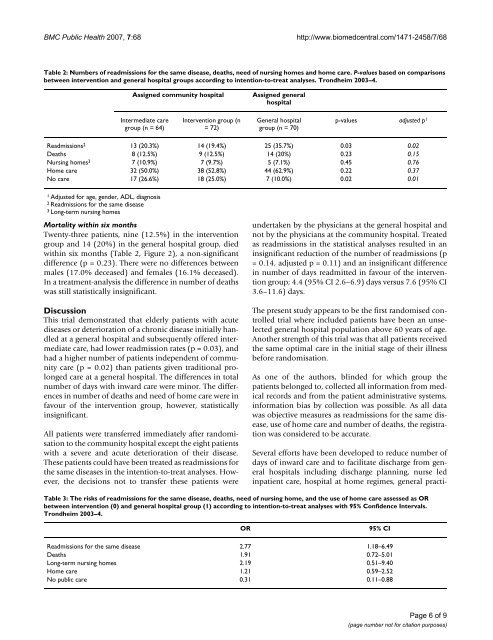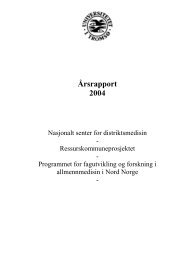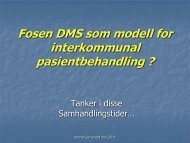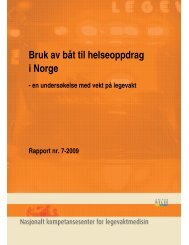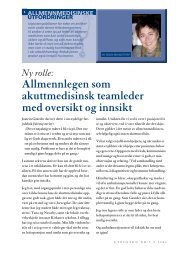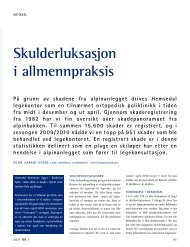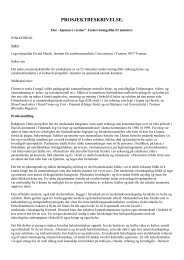Helge Garåsen The Trondheim Model - NSDM
Helge Garåsen The Trondheim Model - NSDM
Helge Garåsen The Trondheim Model - NSDM
You also want an ePaper? Increase the reach of your titles
YUMPU automatically turns print PDFs into web optimized ePapers that Google loves.
BMC Public Health 2007, 7:68<br />
http://www.biomedcentral.com/1471-2458/7/68<br />
Table 2: Numbers of readmissions for the same disease, deaths, need of nursing homes and home care. P-values based on comparisons<br />
between intervention and general hospital groups according to intention-to-treat analyses. <strong>Trondheim</strong> 2003–4.<br />
Assigned community hospital<br />
Assigned general<br />
hospital<br />
Intermediate care<br />
group (n = 64)<br />
Intervention group (n<br />
= 72)<br />
General hospital<br />
group (n = 70)<br />
p-values adjusted p 1<br />
Readmissions 2 13 (20.3%) 14 (19.4%) 25 (35.7%) 0.03 0.02<br />
Deaths 8 (12.5%) 9 (12.5%) 14 (20%) 0.23 0.15<br />
Nursing homes 3 7 (10.9%) 7 (9.7%) 5 (7.1%) 0.45 0.76<br />
Home care 32 (50.0%) 38 (52.8%) 44 (62.9%) 0.22 0.37<br />
No care 17 (26.6%) 18 (25.0%) 7 (10.0%) 0.02 0.01<br />
1 Adjusted for age, gender, ADL, diagnosis<br />
2 Readmissions for the same disease<br />
3 Long-term nursing homes<br />
Mortality within six months<br />
Twenty-three patients, nine (12.5%) in the intervention<br />
group and 14 (20%) in the general hospital group, died<br />
within six months (Table 2, Figure 2), a non-significant<br />
difference (p = 0.23). <strong>The</strong>re were no differences between<br />
males (17.0% deceased) and females (16.1% deceased).<br />
In a treatment-analysis the difference in number of deaths<br />
was still statistically insignificant.<br />
Discussion<br />
This trial demonstrated that elderly patients with acute<br />
diseases or deterioration of a chronic disease initially handled<br />
at a general hospital and subsequently offered intermediate<br />
care, had lower readmission rates (p = 0.03), and<br />
had a higher number of patients independent of community<br />
care (p = 0.02) than patients given traditional prolonged<br />
care at a general hospital. <strong>The</strong> differences in total<br />
number of days with inward care were minor. <strong>The</strong> differences<br />
in number of deaths and need of home care were in<br />
favour of the intervention group, however, statistically<br />
insignificant.<br />
All patients were transferred immediately after randomisation<br />
to the community hospital except the eight patients<br />
with a severe and acute deterioration of their disease.<br />
<strong>The</strong>se patients could have been treated as readmissions for<br />
the same diseases in the intention-to-treat analyses. However,<br />
the decisions not to transfer these patients were<br />
undertaken by the physicians at the general hospital and<br />
not by the physicians at the community hospital. Treated<br />
as readmissions in the statistical analyses resulted in an<br />
insignificant reduction of the number of readmissions (p<br />
= 0.14, adjusted p = 0.11) and an insignificant difference<br />
in number of days readmitted in favour of the intervention<br />
group; 4.4 (95% CI 2.6–6.9) days versus 7.6 (95% CI<br />
3.6–11.6) days.<br />
<strong>The</strong> present study appears to be the first randomised controlled<br />
trial where included patients have been an unselected<br />
general hospital population above 60 years of age.<br />
Another strength of this trial was that all patients received<br />
the same optimal care in the initial stage of their illness<br />
before randomisation.<br />
As one of the authors, blinded for which group the<br />
patients belonged to, collected all information from medical<br />
records and from the patient administrative systems,<br />
information bias by collection was possible. As all data<br />
was objective measures as readmissions for the same disease,<br />
use of home care and number of deaths, the registration<br />
was considered to be accurate.<br />
Several efforts have been developed to reduce number of<br />
days of inward care and to facilitate discharge from general<br />
hospitals including discharge planning, nurse led<br />
inpatient care, hospital at home regimes, general practi-<br />
Table 3: <strong>The</strong> risks of readmissions for the same disease, deaths, need of nursing home, and the use of home care assessed as OR<br />
between intervention (0) and general hospital group (1) according to intention-to-treat analyses with 95% Confidence Intervals.<br />
<strong>Trondheim</strong> 2003–4.<br />
OR<br />
95% CI<br />
Readmissions for the same disease 2.77 1.18–6.49<br />
Deaths 1.91 0.72–5.01<br />
Long-term nursing homes 2.19 0.51–9.40<br />
Home care 1.21 0.59–2.52<br />
No public care 0.31 0.11–0.88<br />
Page 6 of 9<br />
(page number not for citation purposes)


